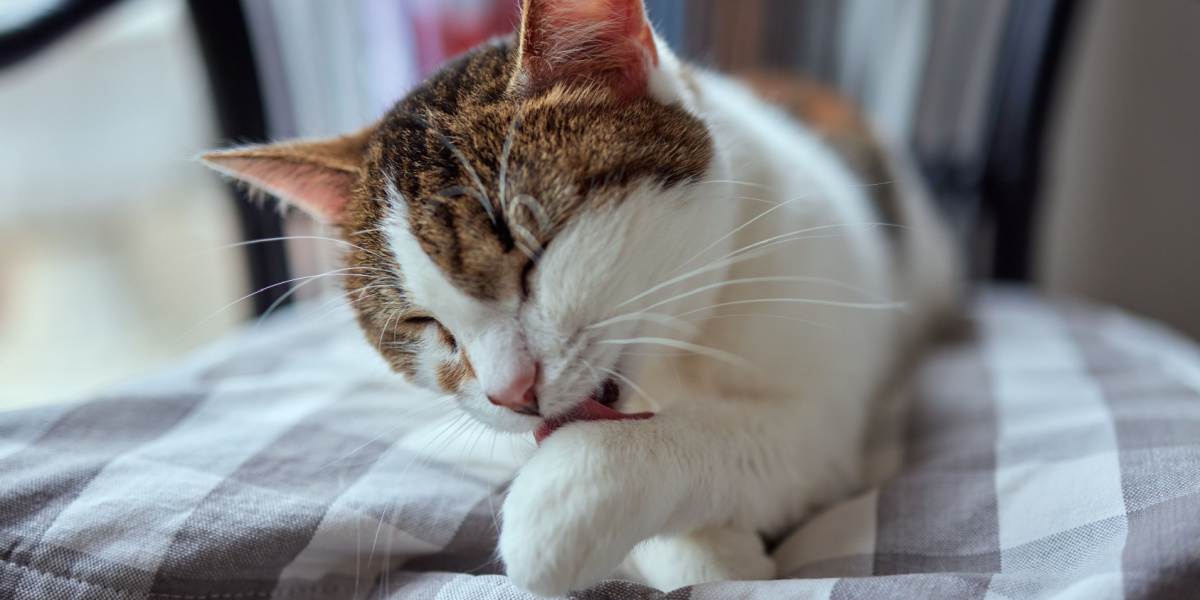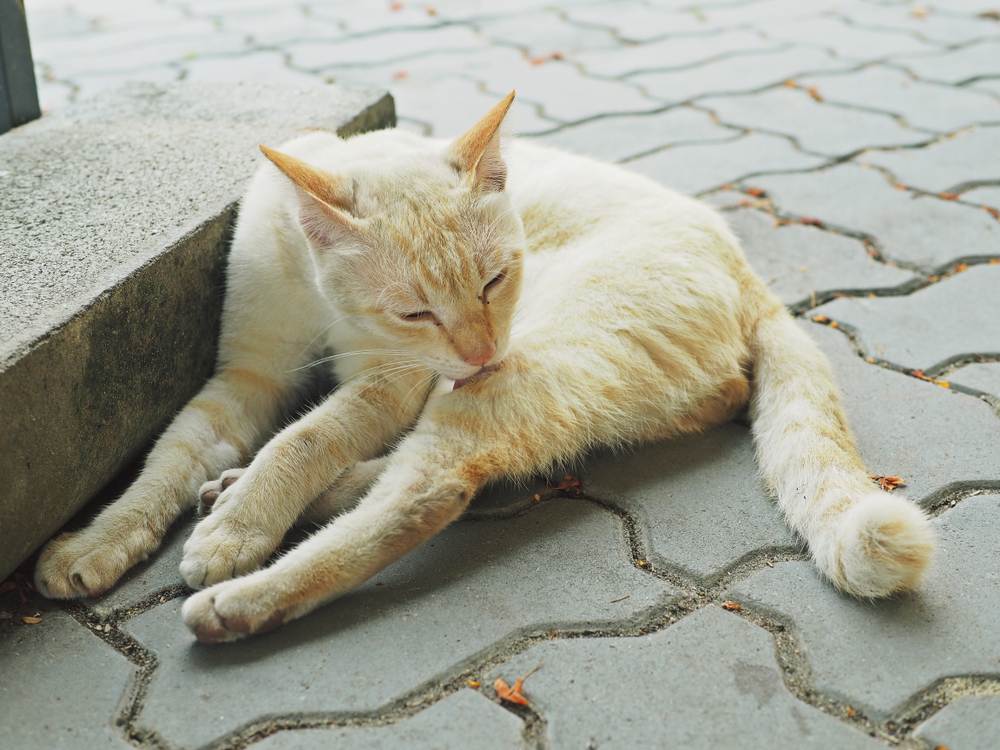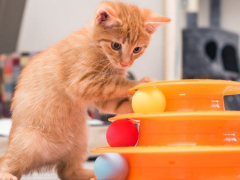
If you have a wounded cat, and notice them cleaning their wounds, you might be wondering if or when you should stop your cat from licking their wounds. Cats like to lick, after all. They like to lick the gravy off their food, they lick each other when they are being sociable, and grooming is a quintessential feline pastime. Their inherent cleanliness is one of the reasons so many of us love to share our homes with felines.
However, this usually endearing behavior can sometimes be harmful. A cat overgrooming a wound or surgery site can hamper wound healing and leave both cat and owner frustrated.
A cat's natural instinct is to lick at any cut, wound, or sore on their body, just as they would try to heal themselves in the wild. A cat licking a wound can harm its healing by causing trauma or infection in the affected area. There are several methods that can stop a cat from licking their wounds, depending on the location of the wound and the individual cat.Key Takeaways
Is a Cat Licking Their Wound Good or Bad?
It is commonly thought that cats lick at a wound in order to heal it. There is a basis of truth in this. In the wild, a cat will lick an open wound as the only means it has to help the healing process. It might, in doing so, manage to help a little by decontaminating the area and removing debris from the wound.
Fortunately, however, our feline family members now have access to much better veterinary care. We know that cats’ mouths play host to a lot of bacteria, both on their teeth and in their saliva. When a cat licks at an open wound, it transfers infection to the wound. This is the main reason that veterinarians would rather your cat didn’t take it upon themselves to clean a wound.
Cats can also be somewhat obsessive. Over-licking or overgrooming an area can actually cause trauma and damage to the skin. Wounds need time to knit together and heal, and constant disruption to this can prevent the natural healing process from taking place.
When Should I Stop My Cat From Licking Their Wound?
Almost any licking of wounds should be prevented as like we have mentioned, there are better ways to help our cats to heal. The most common times you might have to prevent a cat from licking are:
1. After Surgery
Whether your cat has undergone a routine surgery such as desexing, or an emergency procedure, they will most likely have stitches or staples in their surgical wound. Stitches are sometimes dissolvable but are more commonly removed from the wound once skin healing has occurred 10-14 days after the surgery.
A cat that is allowed to lick the area can damage or even remove their own stitches prematurely, causing bleeding or dehiscence (when the wound falls apart). Cat saliva can also introduce infection to an otherwise clean and sterile surgery site.
2. Trauma

Cats would lick their wounds in the wild to keep them clean, but with veterinary care available, there are more sanitary options than licking.
Accidents can happen to any cat, although outside cats see a far greater incidence of scrapes and trauma. Cats can get caught in places and cut or graze their legs, slice their pads on sharp objects or pieces of wire, and other such incidents.
Your vet is always the best person to treat these mishaps and they will recommend preventing your cat from licking and making matters worse. It is stressful enough when things go wrong, without your cat making matters worse with their overgrooming.
3. Cat Fights
While not unheard of within multi-cat households, most catfights take place between neighboring cats and are a big issue with outside cats. Cats’ teeth can inflict small, sometimes unnoticeable puncture wounds which can develop into an abscess and give your cat a nasty fever.
The discomfort caused by the wound can trigger your cat to lick at the area and this might be the first thing, along with signs of pain, that you notice even without any swelling or bleeding. Fight wounds and abscesses always require veterinary care, as they are unlikely to heal well without veterinary treatment, so do not be tempted to allow your cat to “lick it better.”
How Do I Stop My Cat From Licking Their Wounds?
There are a few tried and tested ways to stop a cat from licking their wound:
1. The Elizabethan Collar
Also known as a “lampshade collar,” an “e-collar,” or even “the cone of shame,” this is the go-to for most licking prevention. It is a cone of firm plastic that is placed around the cat’s neck that prevents them from grooming the rest of their body. E-collars can be attached to your cat’s collar or tied on with a bandage.
Always make sure you can fit two fingers between the bandage and your cat’s neck so that you know it is not too tight. Some cats can be pretty crafty at using their back feet to scratch the cone off their head. In these cases, attaching the collar to a well-fitted cat harness may help, or depending on the sort of wound another method of preventing licking might be more suitable.
2. Soft Collars

Soft collars are becoming more popular as an Elizabethan collar alternative to prevent unwanted licking.
The next generation from Elizabethan collars, soft collars are increasingly popular with pet parents. They can either take the form of an inflatable collar (imagine a travel pillow-type arrangement that goes right the way around your cat’s neck) or a fabric collar that sticks straight out from your cat’s neck.
These are often tolerated better than an e-collar by many cats. However, the downside is that some cats can manage to lick their wounds despite having them on. Foot wounds are particularly hard to protect with a soft collar as a flexible cat will manage to extend their leg around the collar. Beware: any collar means that a cat must be kept indoors to stop the catastrophic scenario of them getting their collar hooked up in a tree or branch.
3. Bandaging
This is a particularly good option for paw and pad wounds. A breathable bandage can be placed over the wound to protect the area from unwanted licking. It has the added bonus of being able to cover the wound with medicated ointments and creams or special dressings to promote optimal wound healing.
Bandages must not be so tight that it constricts the blood flow to the area. They also must be kept clean and dry. A wet, dirty bandage is worse for infection than no bandage at all!
4. Pet Sleeves/Onesies
Probably the most well-tolerated wound protection of them all, pet medical onesies look exactly as you would imagine. There are versions that cover just the body of the cat, or versions with a sleeve to cover a particular limb.
These are fantastic for abdominal and orthopedic wounds. However, bear in mind that they might not be suitable for a wound on a paw or a wound that is producing discharge. Most vets will offer this as an option where appropriate although you can expect to pay a bit more than you would do for the previous options.
Also Read: How To Care For A Wounded Cat
Frequently Asked Questions
How do I stop a cat from licking its wound without a cone?
If you need to stop a cat from licking themselves but do not have access to a cone at home, you can try covering the wound or infected area with a light bandage, ensuring that it is not too tight. You could also try using a pet or baby t-shirt to go over the area.
Providing a distraction for your cat in the form of affection or food games may also help. Pain medication to help ease your cat's discomfort may also help reduce the licking, however, should only ever be administered after consulting a vet.
How do I treat an open wound on a cat?
Consult with your veterinarian as soon as possible. Try to prevent dirt from entering the wound by keeping your cat in a dry, clean environment. If you have a collar or loose bandage that you can safely place on your cat to prevent them licking the wound then do so whilst you seek veterinary care.
Is it OK for my cat to lick his wound after neutering?
Cat neutering/desexing is done under strict aseptic conditions to prevent the wound from becoming infected. It is recommended that you prevent your cat from licking the wound so that they do not contaminate the area with bacteria from their mouth as this can cause wound infections and wound breakdown.







